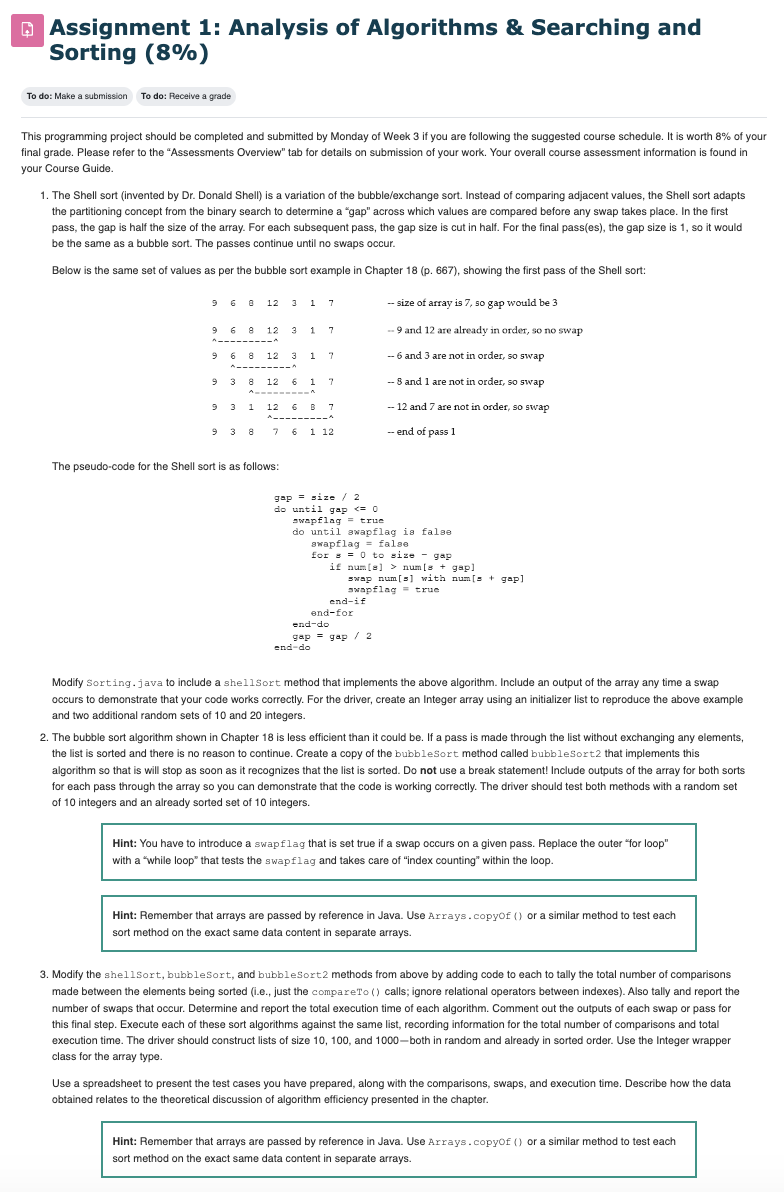Answered step by step
Verified Expert Solution
Question
1 Approved Answer
This programming project should be completed and submitted by Monday of Week 3 if you are following the suggested course schedule. It is worth 8
This programming project should be completed and submitted by Monday of Week if you are following the suggested course schedule. It is worth of your
final grade. Please refer to the "Assessments Overview" tab for details on submission of your work. Your overall course assessment information is found in
your Course Guide.
The Shell sort invented by Dr Donald Shell is a variation of the bubbleexchange sort. Instead of comparing adjacent values, the Shell sort adapts
the partitioning concept from the binary search to determine a "gap" across which values are compared before any swap takes place. In the first
pass, the gap is half the size of the array. For each subsequent pass, the gap size is cut in half. For the final passes the gap size is so it would
be the same as a bubble sort. The passes continue until no swaps occur.
Below is the same set of values as per the bubble sort example in Chapter p showing the first pass of the Shell sort:
The pseudocode for the Shell sort is as follows:do until gap do until swapflag is false for s to size gap swap nums with nums gap endifenddoenddoModify Sorting.java to include a shelSort method that implements the above algorithm. Include an output of the array any time a swap
occurs to demonstrate that your code works correctly. For the driver, create an Integer array using an initializer list to reproduce the above example
and two additional random sets of and integers.
The bubble sort algorithm shown in Chapter is less efficient than it could be If a pass is made through the list without exchanging any elements,
the list is sorted and there is no reason to continue. Create a copy of the bubbleSort method called bubbleSort that implements this
algorithm so that is will stop as soon as it recognizes that the list is sorted. Do not use a break statement! Include outputs of the array for both sorts
for each pass through the array so you can demonstrate that the code is working correctly. The driver should test both methods with a random set
of integers and an already sorted set of integers.
Hint: You have to introduce a swap flag that is set true if a swap occurs on a given pass. Replace the outer "for loop"
with a "while loop" that tests the swapflag and takes care of "index counting" within the loop.
Hint: Remember that arrays are passed by reference in Java. Use Arrays copyof or a similar method to test each
sort method on the exact same data content in separate arrays.
Modify the shelSort, bubbleSort, and bubbleSort. methods from above by adding code to each to tally the total number of comparisons
made between the elements being sorted ie just the compareTo calls; ignore relational operators between indexes Also tally and report the
number of swaps that occur. Determine and report the total execution time of each algorithm. Comment out the outputs of each swap or pass for
this final step. Execute each of these sort algorithms against the same list, recording information for the total number of comparisons and total
execution time. The driver should construct lists of size and both in random and already in sorted order. Use the Integer wrapper
class for the array type.
Use a spreadsheet to present the test cases you have prepared, along with the comparisons, swaps, and execution time. Describe how the data
obtained relates to the theoretical discussion of algorithm efficiency presented in the chapter.
Hint: Remember that arrays are passed by reference in Java. Use Arrays copyof or a similar method to test each
sort method on the exact same data content in separate arrays.
Do it in Java

Step by Step Solution
There are 3 Steps involved in it
Step: 1

Get Instant Access to Expert-Tailored Solutions
See step-by-step solutions with expert insights and AI powered tools for academic success
Step: 2

Step: 3

Ace Your Homework with AI
Get the answers you need in no time with our AI-driven, step-by-step assistance
Get Started


